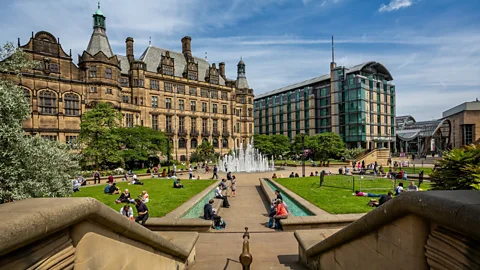ADS
Utah’s Grand Staircase-Escalante National Monument’s impassable gorges elude even its most knowledgeable visitors.
Rick Green, an adventure guide, is exploring a wild and uncharted frontier in the wilderness beyond Escalante, a tiny Utah town of drive-by eateries and dust devils, and down a narrow slot canyon.
The ravine twists and turns before entering a labyrinth of undiscovered gorges with streaky orange rock, the color of a brilliant sunset. It dips 30m from an apron of rocky terrain to a desert floor, dropping from 100ft to 1ft. It’s silent everywhere.
With the canyon giving refuge from the 40C heat, Green continues with a helmet, harness, climbing rope, rappel rings, and carabiners to descend into the hidden valley. There are few exits further.
It was the final 1870s American exploration. It was so hazardous that everyone passed it by.
“No one was interested in this place for a very long time,” said Escalante Excursions co-owner Green. This is where the Henrys, America’s final mountain range, were named. It has the last-named rivers. It was the final 1870s American exploration. Because it was unsafe, everyone passed it by.”
The Grand Staircase-Escalante National Monument in southern Utah is one of the nation’s most dangerous and inaccessible areas. This concertina of plateaus, ridges, cliffs, and escarpments has never been truly conquered or comprehended by any American, Indigenous or otherwise. It’s larger than Delaware and Rhode Island.
Importantly for cartographiles, it was the final continental US location mapped.
Green believes there are hundreds more slot and slickrock canyons here that have never been studied. However, he has built a profession surveying 30 of the most accessible to better comprehend southern Utah’s wilds. “Grand Staircase-Escalante gets canyoners like me up in the mornings,” remarked. “We have most. The most crowded. Better yet, the most gorgeous.”
From orbit, the national monument looks like a giant’s ladder from the Colorado Plateau to the Grand Canyon. An ancient tangle of jagged cliffs and rising mesas is seen up close. Other revelations await on paper. It encompasses Anasazi and Fremont lands, spans five bio-zones from low-lying desert to coniferous forest, and comprises 1.87 million acres of American public property.
The national monument, established by Bill Clinton in 1996, remains politicized. President Biden issued a presidential proclamation in October 2021 to amend the borders and restore the preservation order after former US President Trump cut the land in half for development.
“This high, rugged, and remote region, where bold plateaus and multi-hued cliffs run for distances that defy human perspective, was the last place in the continental United States to be mapped,” the decree adds. “The monument has a long and dignified human history: it is a place where one can see how nature shapes human endeavours in the American West, where distance and aridity have been pitted against our dreams and courage.”
According to late 1880s sources, pioneers tried to design a shortcut to the San Juan River from Escalante to Fortymile Spring, but the terrain was too hard. Proof that nowhere in America was tougher to overcome, says the statement.
The best account is Angus M. Woodbury’s A History of Southern Utah and Its National Parks. After failing to capture the most challenging portions of the Kaiparowits Plateau in Grand Staircase-Escalante National Monument, a brave group of scouts retreated in despair.
“Envoys were sent to Salt Lake City to appeal for assistance, which was given in the form of a legislative appropriation for blasting a way through,” the report says.
Grand Staircase-Escalante National Monument Manager Adé Nelson sees the terrain as a mystery and a geographical conundrum that may never be solved. “Due to the rough and rugged terrain, there are portions of the monument that are totally unreachable and will probably never be fully mapped,” said.
Because of the harsh terrain, parts of the monument remain inaccessible and may never be properly surveyed.
Canyonlands are now a frontier in a new way. Scientists call it the “Science Monument” because it has become a massive outdoor laboratory where they study our environment, history, and planet’s past. Ocean-free mountain ranges have Cretaceous-era oyster and clam shells. Petrified crocodiles and three-toed Tyrannosaurus Rex footprints await discovery. It has bones and artifacts like a landscape-scale natural history museum.
In the 27 years since the monument’s designation, hundreds of studies have been conducted, from studying how the monument’s geology reveals Mars’ hydrology to finding some of the oldest marsupial fossils and many new dinosaur species, including North America’s oldest mosasaur, Sarabosaurus dahli, found in June 2023.
“On average, one new species is formally recognised each year as a result of paleontological research done in the monument,” said Megan Crandall, a BLM representative. The BLM manages all US public property, including the National Monument. “A T2 Tyrannosaur excavated at the Kaiparowits Formation starting in 2020 was so large that scientists struggled to figure out how to split up the specimen for transport.”
The labyrinthine terrain is host to ancient petroglyphs, campsites, burial areas, and granaries, despite expectations of scant human presence. It contains Indigenous Native American culture and mythology. The area’s mountainous backbone is still known as Dził Bizhiʼ Ádiní (“The mountain whose name is missing”) in the Navajo language.
The Anasazi State Park Museum in Boulder, Colorado, borders the National Monument and tells stories like these. Most impressively, 162,000 artifacts have been unearthed from the location where the Anasazi, also known as the Ancestral Puebloans of the American West, lived as early as 200 BCE.
Park manager Jamie Skidmore stated, “The Anasazi really survived on the edge of nowhere here,” and now speaks for the spirits of the past. “It’s always been a hard place to survive with lack of water and food – it’s little surprise this ancient community eventually fled because of hardship and drought.”
Tourism is changing attitudes and opening up the terrain. Most of the monument is inaccessible unless on foot, however Grand Canyon Trust’s interactive map shows a few pathways. In slot canyons like Peek-a-boo and Spooky and paths to Lower Calf Creek Falls and Willis Creek Narrows, hearts race and mouths drop.
“These lands are a source of inspiration and learning for some and peace, resilience, and unity for others,” said Harry Barber, BLM manager of Paria River District in southern Utah. “I run or bike on the monument every morning. There, I strengthen my focus for the day. Others I encounter on the route are probably there for the same reasons.”
Clearly, the earth teaches. However, it may teach unwary travelers unpleasant lessons. Little to no phone reception over the monument. Juniper and pine trees cut their branches to endure the heat. Flash floods in slot canyons often kill.
America’s wildest national monument reminds us that adventure—elemental, infinite, unpredictable—is always around.





